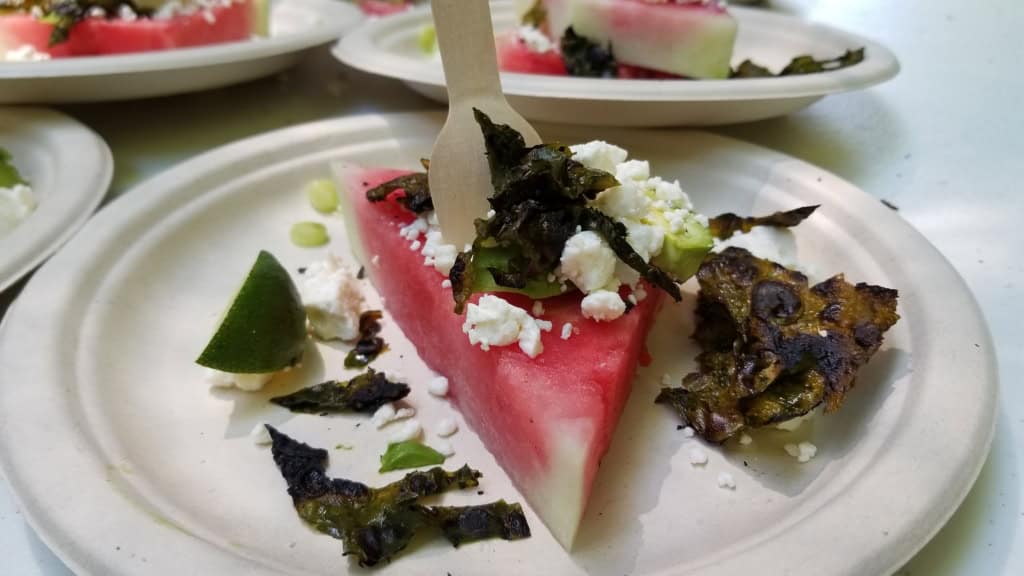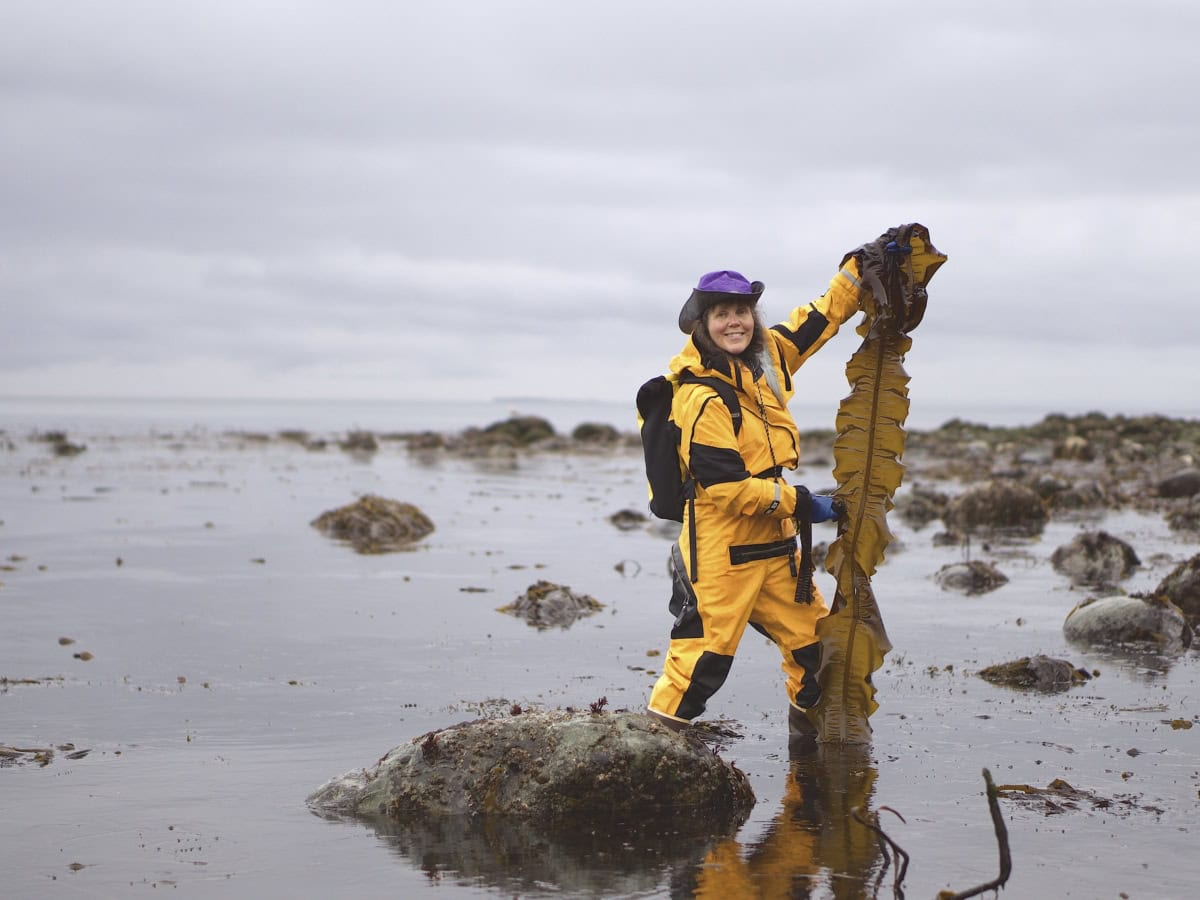
Pacific Harvest: Watermelon Kelp Salad
SEA VEGGIES BOOST YOUR HEALTH AND FLAVORS!
The first time I tasted wild nori, it was served up in crispy handfuls from a recycled cereal box in the remote First Nations village of Gwayasdums on Gilford Island, British Columbia. The dark, crumpled wads had a vaguely pearlescent, purple-black surface. They tasted of smoked salmon and crunched like popcorn. I didn’t know it then, but the Elders who had picked and processed this seaweed by hand weeks earlier were sharing one of their most cherished traditional foods and trade items.
Nori is the Japanese name for two genera of red seaweed—Pyropia and Porphyra. Of the nearly two dozen species that flag the Pacific shores, P. abbottiae is said to be the tastiest and has a relatively brief season compared to its nori cousins. It is called “black seaweed” and “black gold” by First Nations because it dries to a lustrous black and is highly valued. During high tide, the blades appear like blooming roses on underwater cliffs and boulders. Come low tide, they droop like spent party balloons. Black seaweed peaks in late May. Soon after, it degenerates into something resembling a wave-beaten white tissue—or nothing at all. But before that, pound for pound, nori costs as much as steak! Thank goodness so many other species of tasty nori bloom into late summer, since nori, no matter the species you pick, is a nutritional powerhouse.
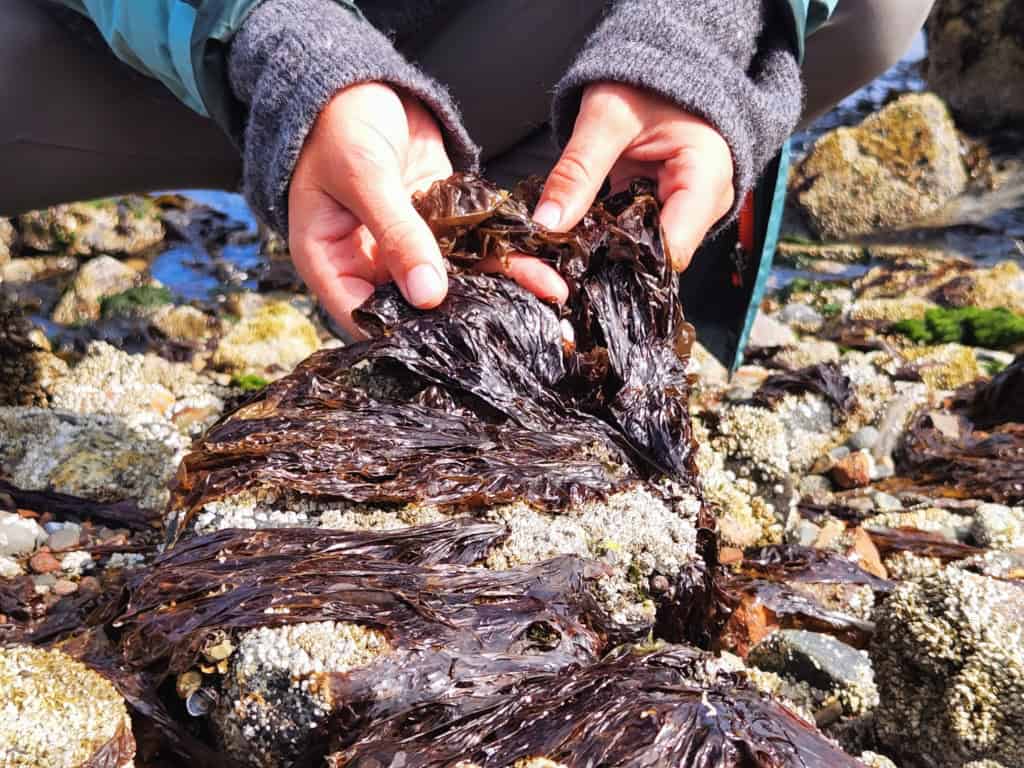 Nori is one of the healthiest foods on Planet Ocean. Dried nori is almost 30 per- cent complete protein. Exceptionally digestible, it is loaded with minerals such as iron, potassium, calcium, iodine, and zinc and vitamins A, B1, B2, B3, B6, B12, C, and E. And it apparently lowers blood cholesterol. I was sold on its vivacious benefits long before I looked at a nutritional chart. During monthlong coastal kayak expeditions, whenever I felt my energy lag, I paddled up to a rocky shoreline, cut off a few blades of nori, and popped them in my mouth. Or I’d reach into my jacket pocket for sun-dried nori nuggets. Within fifteen minutes, I could feel an energy surge. It was nature’s version of an energy drink.
Nori is one of the healthiest foods on Planet Ocean. Dried nori is almost 30 per- cent complete protein. Exceptionally digestible, it is loaded with minerals such as iron, potassium, calcium, iodine, and zinc and vitamins A, B1, B2, B3, B6, B12, C, and E. And it apparently lowers blood cholesterol. I was sold on its vivacious benefits long before I looked at a nutritional chart. During monthlong coastal kayak expeditions, whenever I felt my energy lag, I paddled up to a rocky shoreline, cut off a few blades of nori, and popped them in my mouth. Or I’d reach into my jacket pocket for sun-dried nori nuggets. Within fifteen minutes, I could feel an energy surge. It was nature’s version of an energy drink.
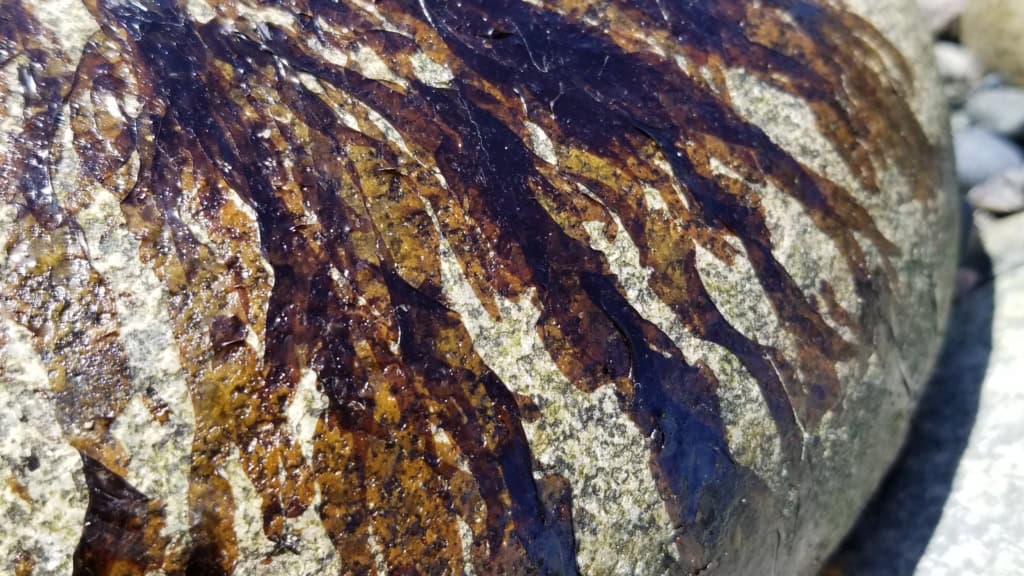
Apparently, it is even more nutritious (bioavailable is the word) when prepared using First Nations culinary traditions. This painstaking and time-intensive process hearkens back hundreds if not thousands of years. It is no less impressive than the European traditions of curing prize olives or aging artisan cheese. Traditional foodways involved gathering and partially drying black seaweed on intertidal rocks by arranging them in square patterns while waiting for family members fishing by canoe to return. First Nations women fermented the squares of slippery blades in a spritz of clam or chiton juice. The partially fermented leaves were pressed into red cedar boxes between layers of cedar branches. Women packed the boxes so tightly that the lids had to be tied with cord and weighted with rocks. After several days, the seaweed blades were aired, re-spritzed, then returned to the boxes. The process was repeated, after which the nori was cut, dried, and smoked beside the fire. The result was a highly prized possession served at potlatches; traded for mountain goat meat, wool, and eulachon oil (rendered from small smelt); and given as gifts. It was even more valuable nutritionally because the fermentation apparently makes it a cinch to digest.
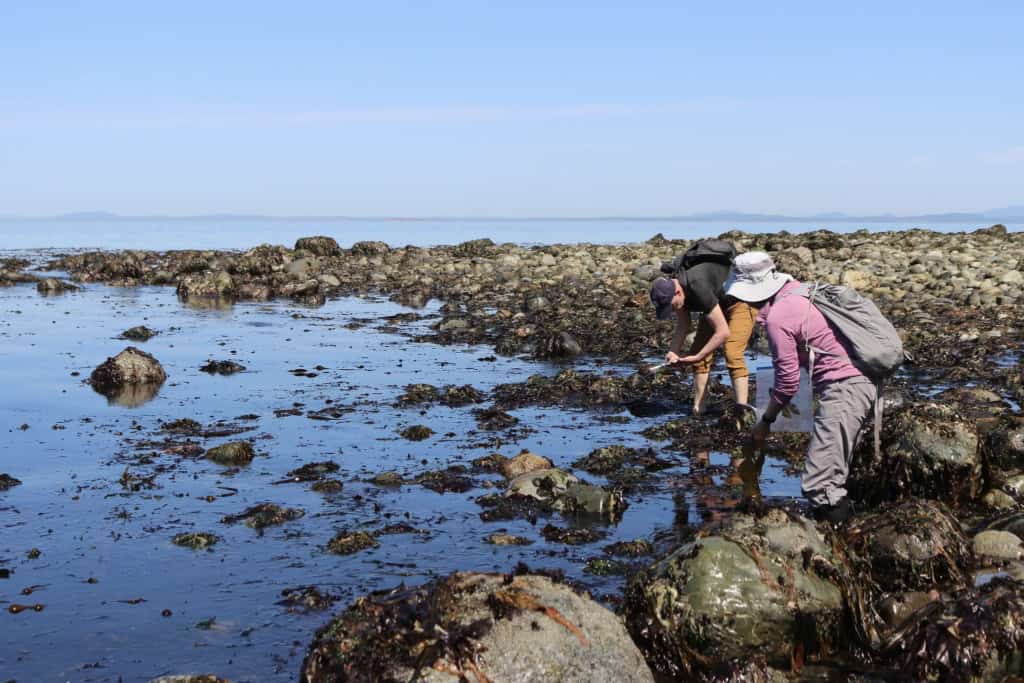
It’s no secret that nori is delicious. The Japanese have been rolling sushi rice in dried leaves (called nori maki) since the early 1700s. Hawked from food stalls as one of the first fast foods, nori was so valuable it could be used as currency to pay tribute taxes as early as the eighth century. Japanese farmers grow the luscious blades on nets sus- pended by poles in quiet, shallow bays or on rafts in deep water. In 1963, these pelagic farmers even built a shrine overlooking the Ariake Sea to honor the British phycologist (seaweed scientist) Dr. Kathleen Drew-Baker, who cracked the code on nori’s complex life cycle by discovering it had two life cycle stages: one as a filamentous hair on the inside of seashells and one as a silky blade. And eureka! Drew-Baker’s attentive eye enabled Japanese nori mariculture to become a billion-dollar industry. Today, a Shinto priest prays over the nori-goddess shrine daily.
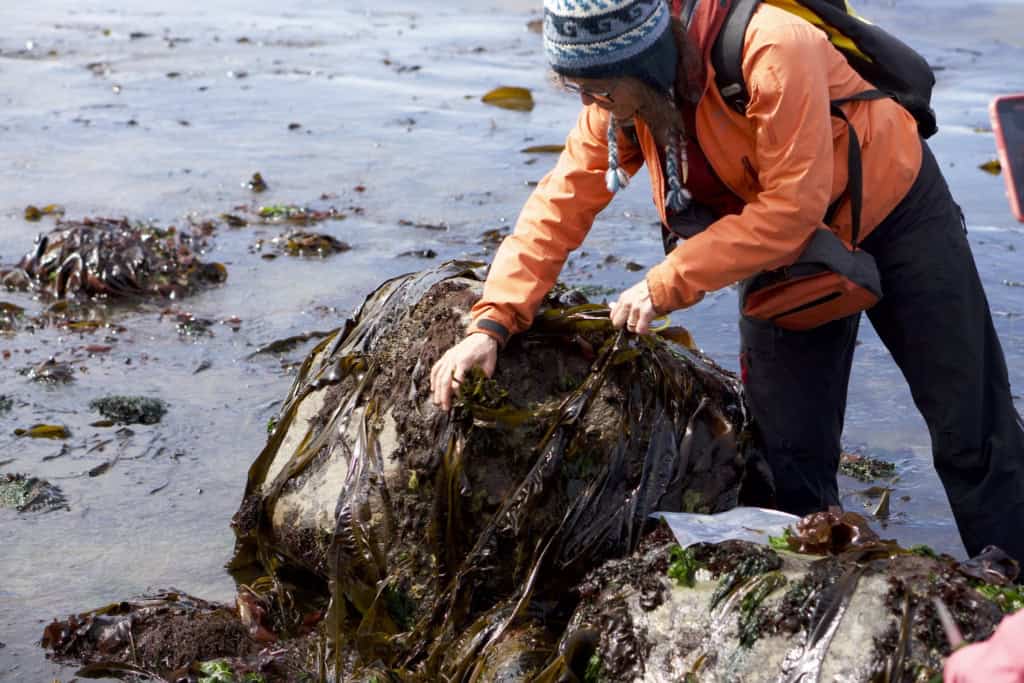
On this side of the Pacific Rim, I pay homage to another red seaweed too. I’ve discovered wild dulse, Palmaria mollis. Catching sight of its scarlet, palm-shaped blade waving in the shallow water turns my anticipating tongue into a tide pool. “Sea bacon” is the name sensationalized in the media recently. Dulse is now grown in bubbling terrestrial tanks for year-round eats. As it grows and rolls about, it maintains a bushy form like an ocean-going tumbleweed. In the kitchen, when I toss a blade of dulse seaweed in a sizzling-hot pan with oil, it crisps up like sea bacon. Anything bettered by bacon—potato salad, sandwiches, scalloped potatoes, maple-syrup-drizzled pancakes—is fair game for sea bacon.
RECIPE for WATERMELON KELP SALAD
We make this salad at our seaweed workshops all the time. It is amazingly easy and flavorful! This makes enough to serve plated salads for a big summer picnic with friends and family, but it’s easy to halve with a smaller melon. Makes 12 servings.
- 1 foot-long or basketball-sized watermelon
- 6 avocados, sliced
- 2 cups crumbled feta cheese
- 2 scallions, very thinly sliced 6 limes, quartered
- 1 cup dried kelp pieces
Cut the watermelon into 1-inch-thick rounds, halve the rounds, then cut into triangles and remove the rind.
For each serving, arrange one triangle of watermelon on a plate and top with the avocado slices, crumbled feta, and a scattering of scallions.
Lay two lime quarters on the side of each plate.
Place the dried kelp blades in a small bowl for easy reach so that guests can scatter the kelp atop the salad and squeeze fresh lime juice over it all.
Eat immediately!
Author’s recipe tip: Tasty seaweeds just right for this dish include dried, flaked blades of sugar kelp, giant kelp, or bull kelp; dried puffy fucus tips; pan-fried dulse pieces, or nori seaweed snacks, which you can purchase at most grocery stores broken into large flakes. The goal is a hint of salt and a crisp texture like baked prosciutto.
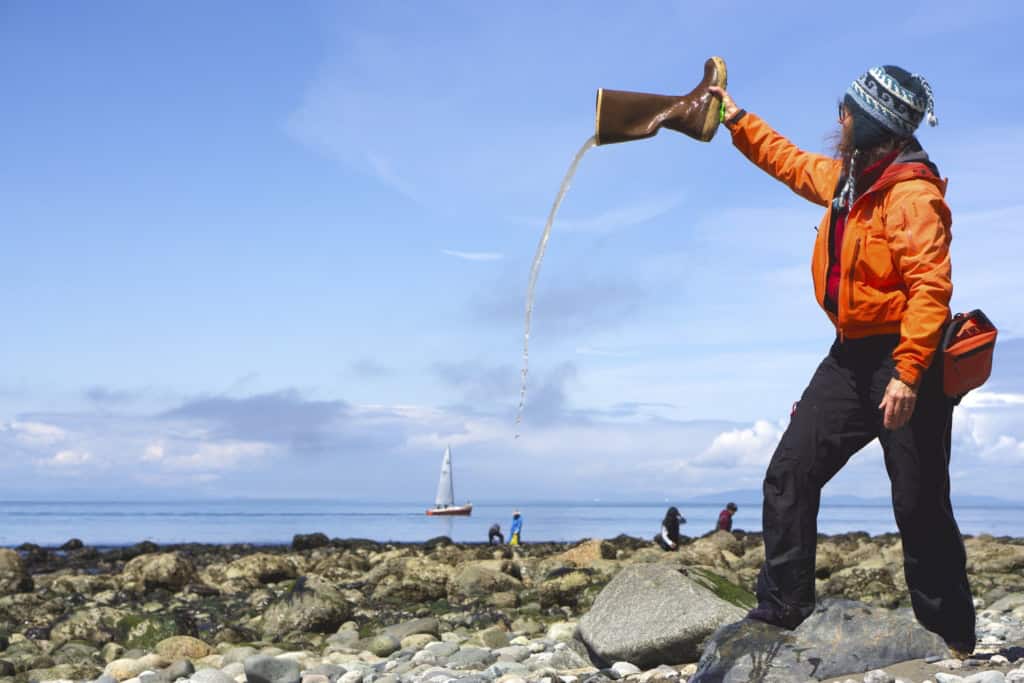 Jennifer Hahn is an author, scientist, teacher, culinary explorer, and wilderness guide. She teaches sustainable wild food harvesting at Fairhaven College of Interdisciplinary Studies at Western Washington University and leads seaweed workshops for the North Cascade Institute, Salish Sea tribes, and First Nations. Her first book Spirited Waters: Soloing South through the Inside Passage won the Barbara Savage Miles from Nowhere award. A naturalist and guide in Southeast Alaska and the Inside Passage, Hahn has been featured on NPR and lives in Bellingham, Washington.
Jennifer Hahn is an author, scientist, teacher, culinary explorer, and wilderness guide. She teaches sustainable wild food harvesting at Fairhaven College of Interdisciplinary Studies at Western Washington University and leads seaweed workshops for the North Cascade Institute, Salish Sea tribes, and First Nations. Her first book Spirited Waters: Soloing South through the Inside Passage won the Barbara Savage Miles from Nowhere award. A naturalist and guide in Southeast Alaska and the Inside Passage, Hahn has been featured on NPR and lives in Bellingham, Washington.
 Excerpted from Pacific Harvest: A Northwest Coastal Foraging Guide (April 2024). Published by Mountaineers Books. All rights reserved. Reprinted with permission.
Excerpted from Pacific Harvest: A Northwest Coastal Foraging Guide (April 2024). Published by Mountaineers Books. All rights reserved. Reprinted with permission.
Purchase your copy here: www.mountaineers.org


